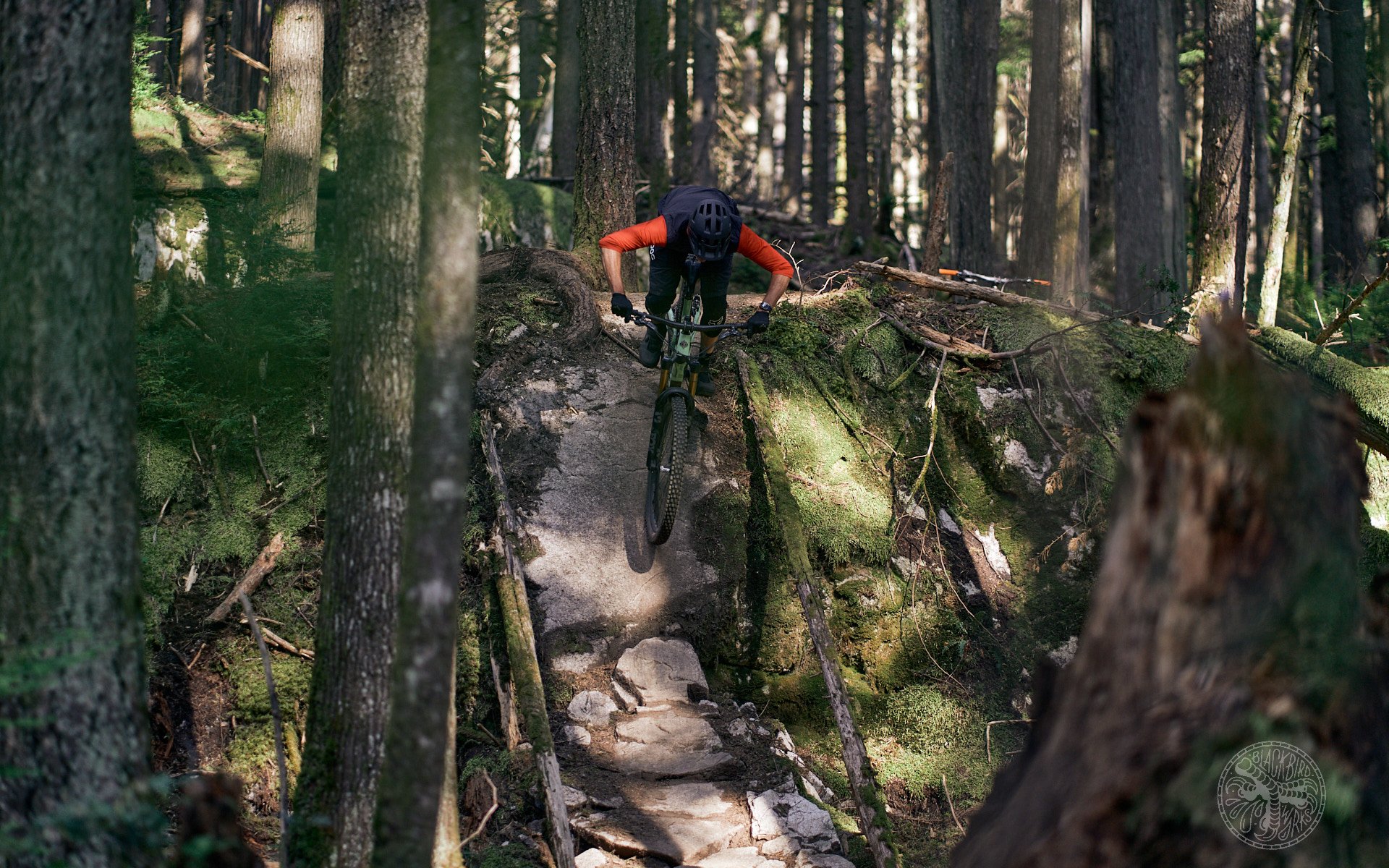
Initial Review
2023 Yeti SB160 T1 First Impressions
I was pretty excited when the Yeti SB160 arrived but the review got off to a lacklustre start. I set the bike up to the recommended parameters and rode it a few times but I was completely underwhelmed. It was okay but it certainly failed to rate as the successor to the highly capable and much-loved SB150 that I rode for several years. Something felt off and looked a little odd from the cockpit as well. Eventually I came to the conclusion that the ride height of the fork seemed low and when I measured it that was indeed the case. The 170mm Fox 38 was actually a 150mm Fox 38. I pushed the relief valves and removed all the air from the fork and started from scratch. The fork would begin to extend as I added air but once I was starting to get close to the target pressure it would begin to suck itself down. Yeti sent me a new fork and from there things started to feel much better.
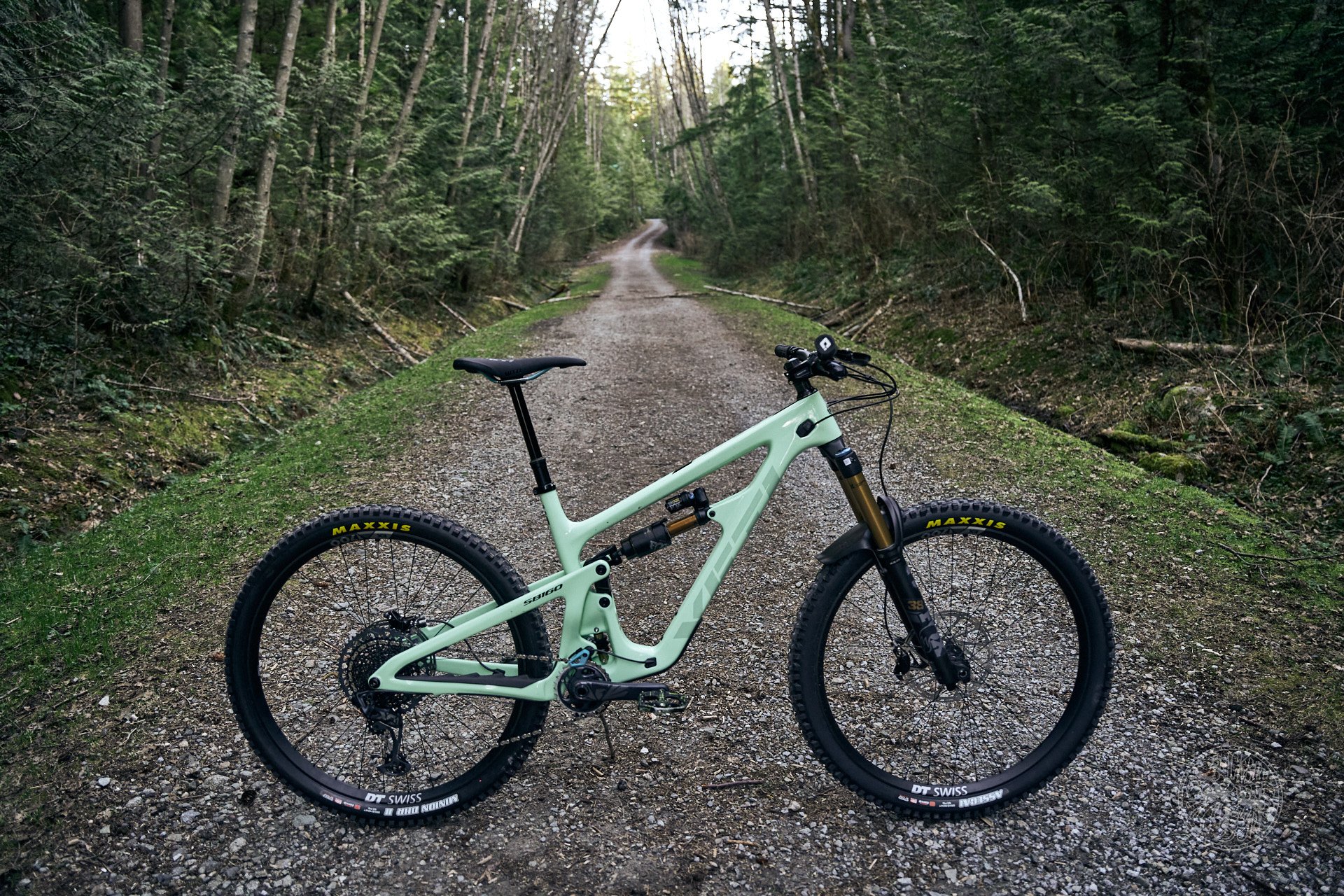
Is that light Turquoise? Yeti calls it Radium and while I'm a fan, the Cobalt blue is even sweeter to my eyes.


The sleight of hand performed by the previous two Yeti bicycles I've tested (and then ridden for a couple of years after that) amounted to feeling like remarkably capable trail bikes much of the time, rather than fully capable enduro machines, until those capabilities were required. I don't have math to help me solve for this particular X. The stays aren't particularly short. The bikes aren't heavy but they are also built to survive King Kong-sized EWS events under the beastly guidance of Richie Rude. Both of these bikes were inclined to dance beneath me and seemingly anticipate movements I hadn't yet realized would be required to circumvent peril.
The SB5.5 had a measly 135mm of rear travel. The SB150 tapped out where you'd imagine. Both of these bikes were unafraid of the most challenging trails here on the North Shore, but the 150 took it up several notches because of the extra travel and evolved geometry. While the bikes shared many elements, the SB150 was a significant upgrade. Whenever a limit was reached, it was because of the pilot rather than the plane.
The SB160, despite being longer, slacker, but not lower than the SB150* has preserved this bloodline. I almost never feel over-biked riding it and I never feel under-biked.
*because of the extra 10mm of travel the SB160's bottom bracket is 5.2mm higher than the SB150
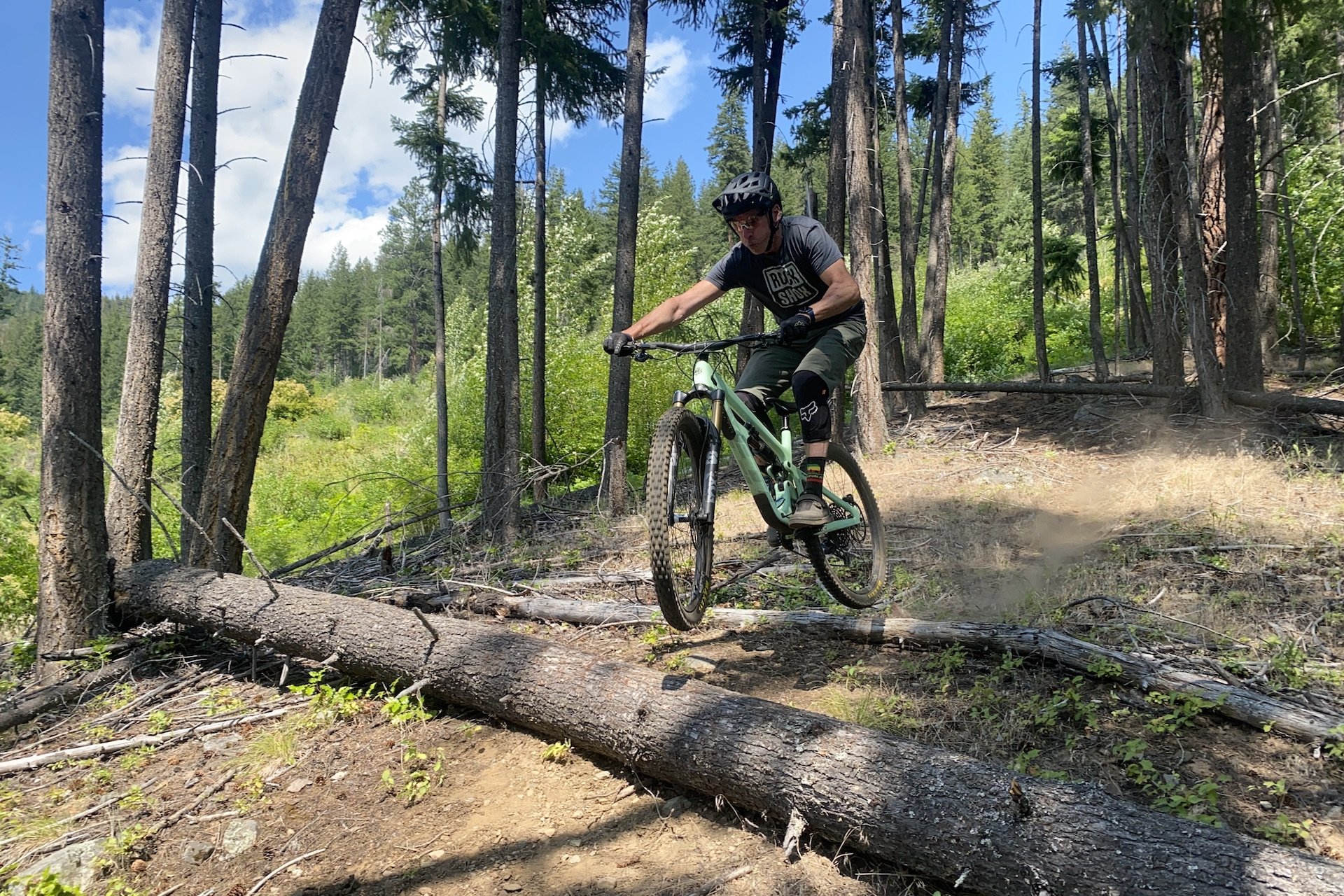
Posting these images is bittersweet for me. Locals may know that the North Shuswap, in B.C.'s interior, was ravaged by fire this past Friday. This was one of the last original sections of a trail called The Spanish Underpants and now it's almost certainly been destroyed by fire.
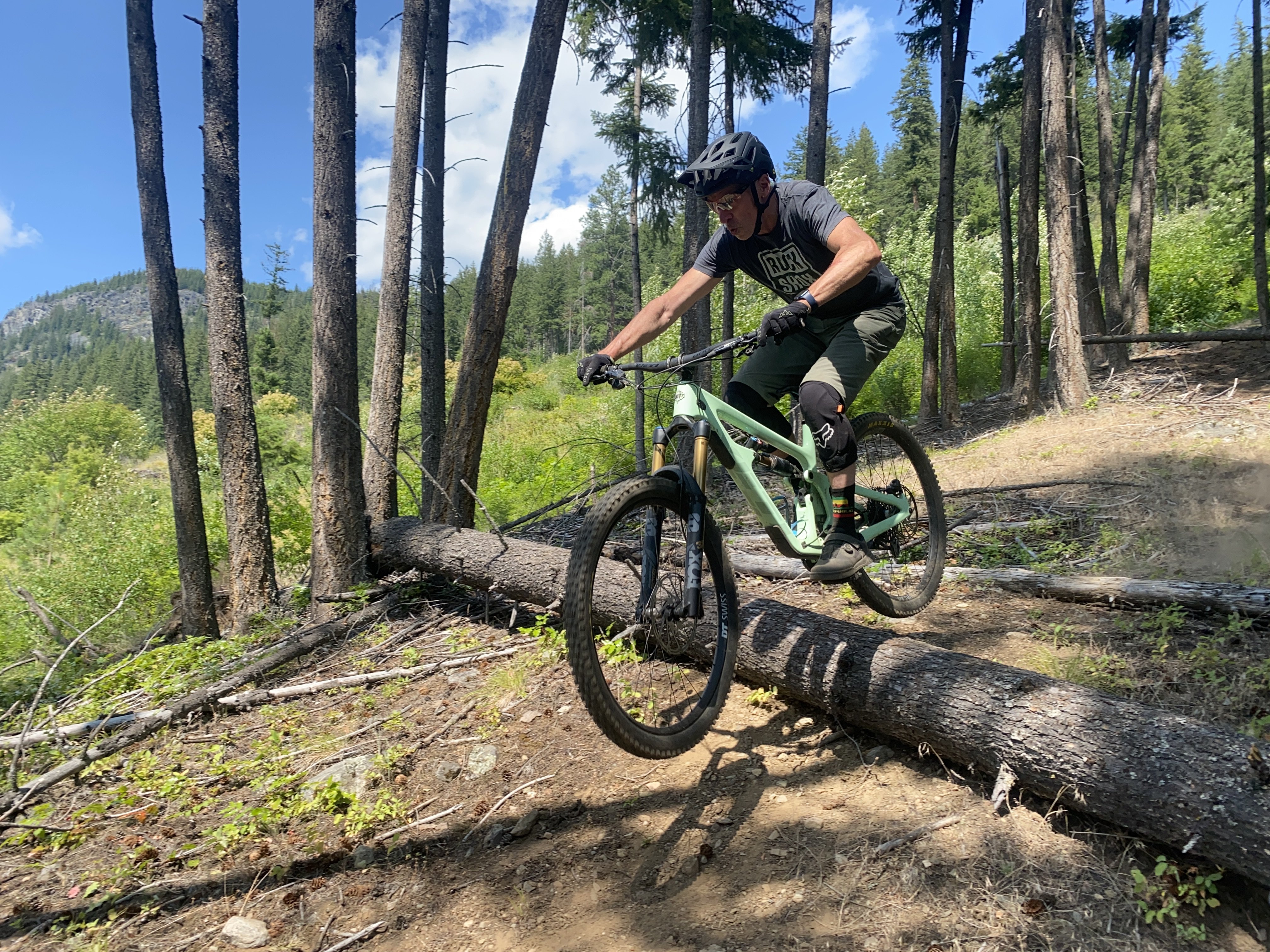
I haven't seen images of this particular area yet but NASA imagery and a timelapse from above this area made it clear the fire went on a rampage here. RIP.
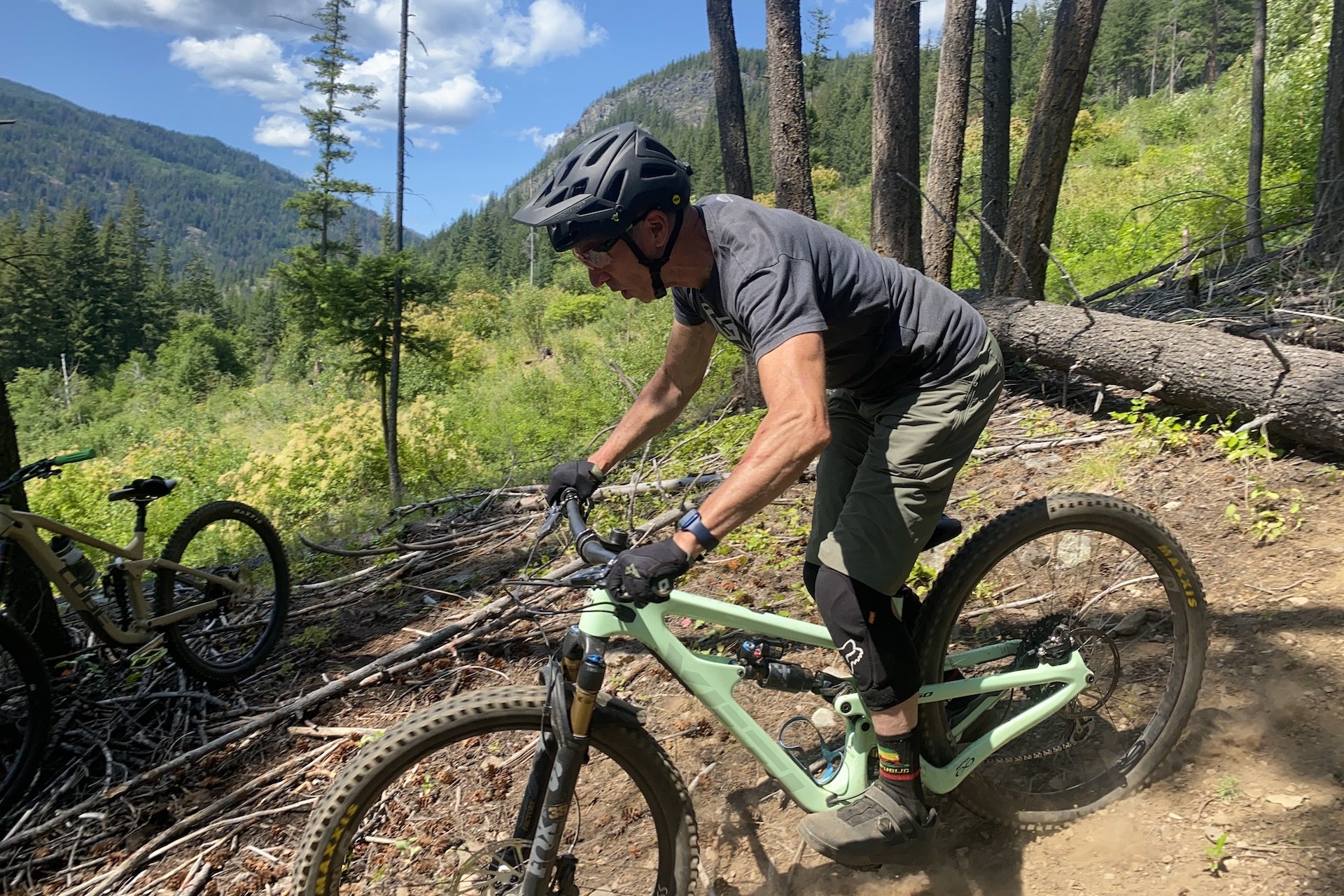
Suspension behaving appropriately. It's important to rein things in here to avoid catastrophe. Photos - Keith Elliott.
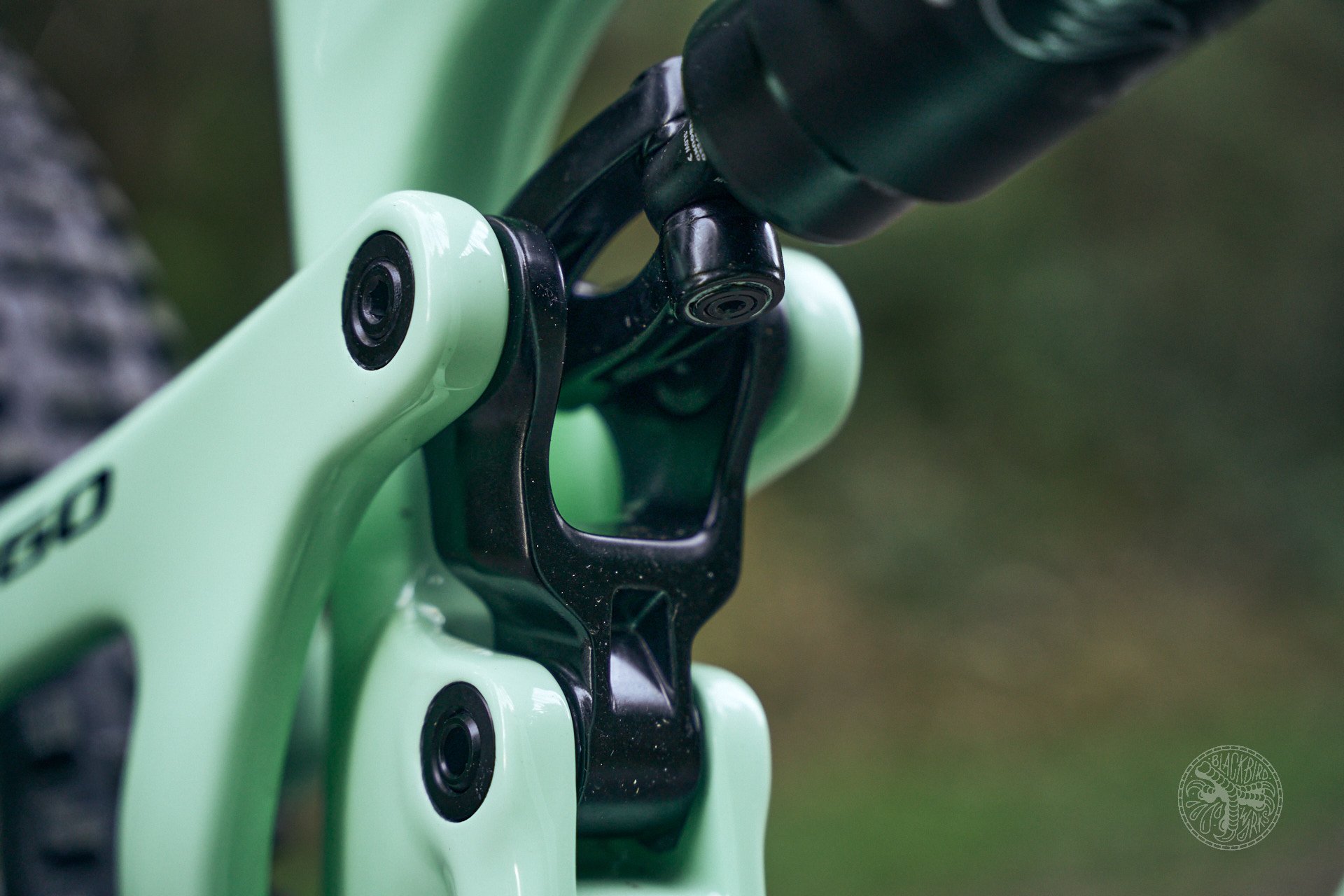
The previous hardware was aligned differently. The previously assembly at the lower part of this image, was a yoke that went around a solid frame member. Now the link assembly slides into a yoke built into the frame.

Some earlier SB150s had a tolerance issue and the wishbone was 3/10 of a millimetre too wide for the frame. As a result the bearings had too much pre-load when tightened properly and the link wouldn't rotate smoothly. I cured this problem on my SB150 using advice from the MTB Engineer's blog. I haven't pulled the link apart yet, but based on everything I've seen so far, I'm quite certain the tolerances are accurate this time around.
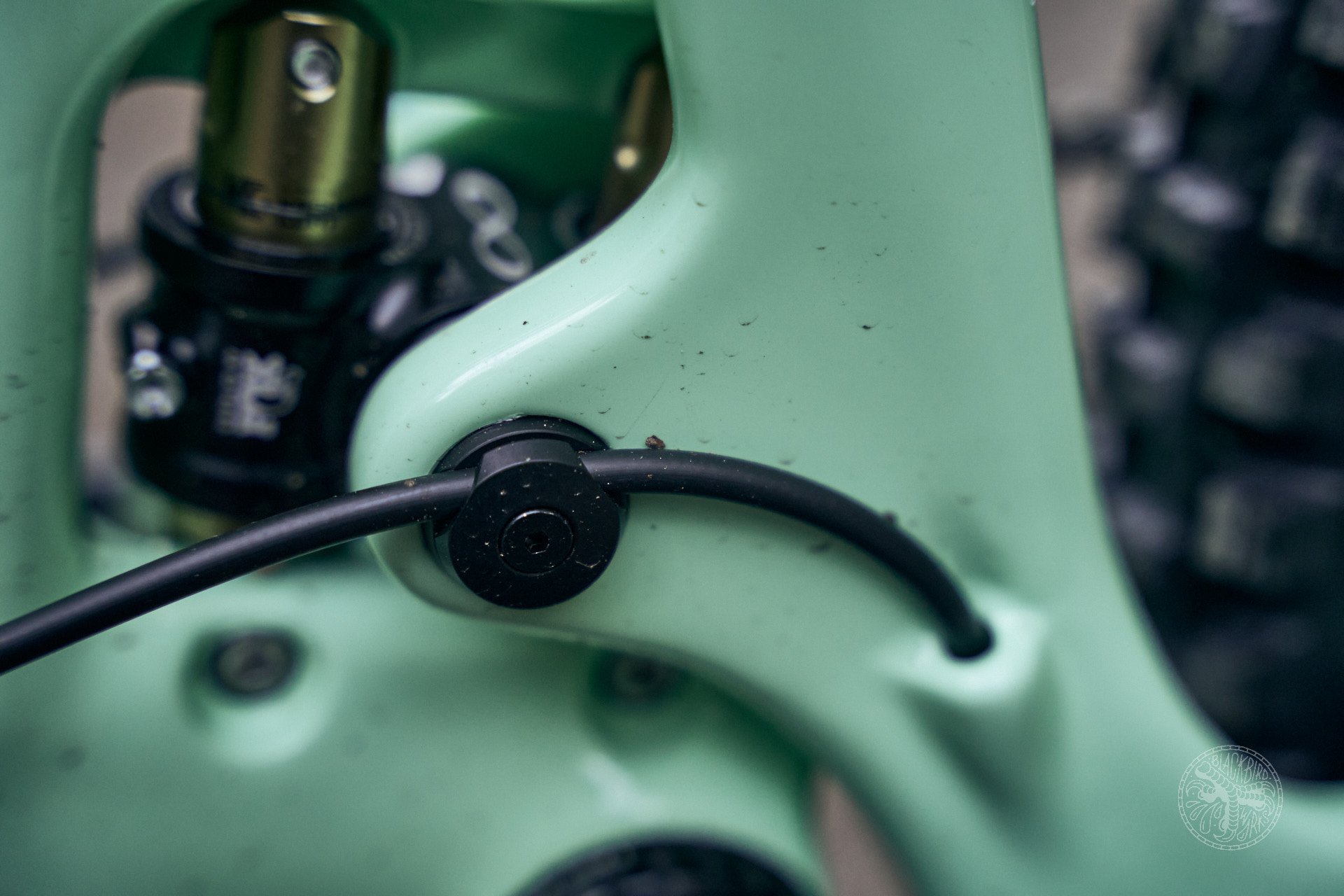
The details on the SB160 are much more refined than the SB150. In fact, the rear brake hose on many 150s begins to saw the frame in half with a lot of riding and no intervention. Those tidy little guides along with new port covers solve that problem.
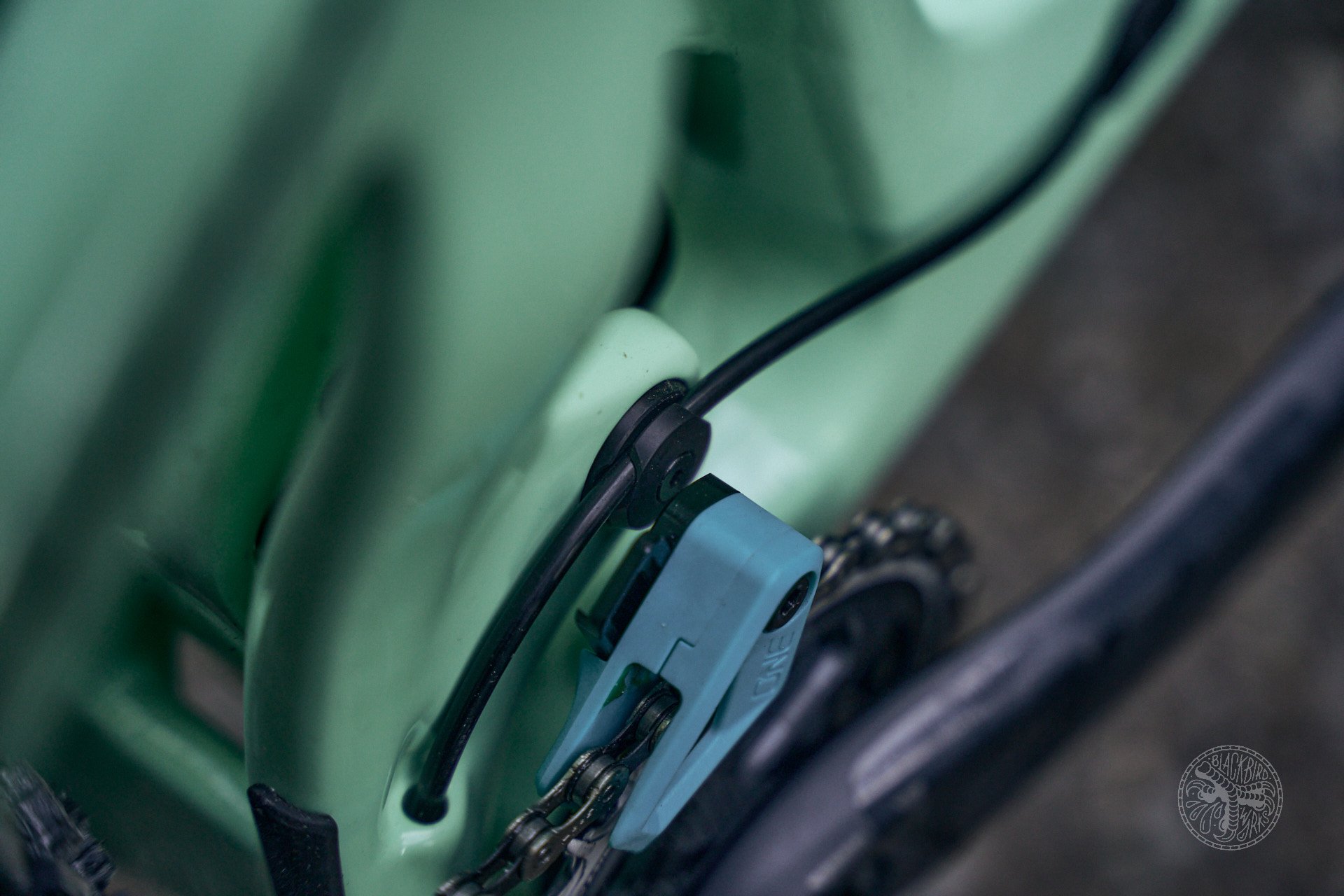
A similar device on the drive side for... cable routing? Surprisingly this bike, at 8,500 USD or 12,300 CAD, doesn't have a single battery and there are no electronic components (and I'm pretty happy about that actually).
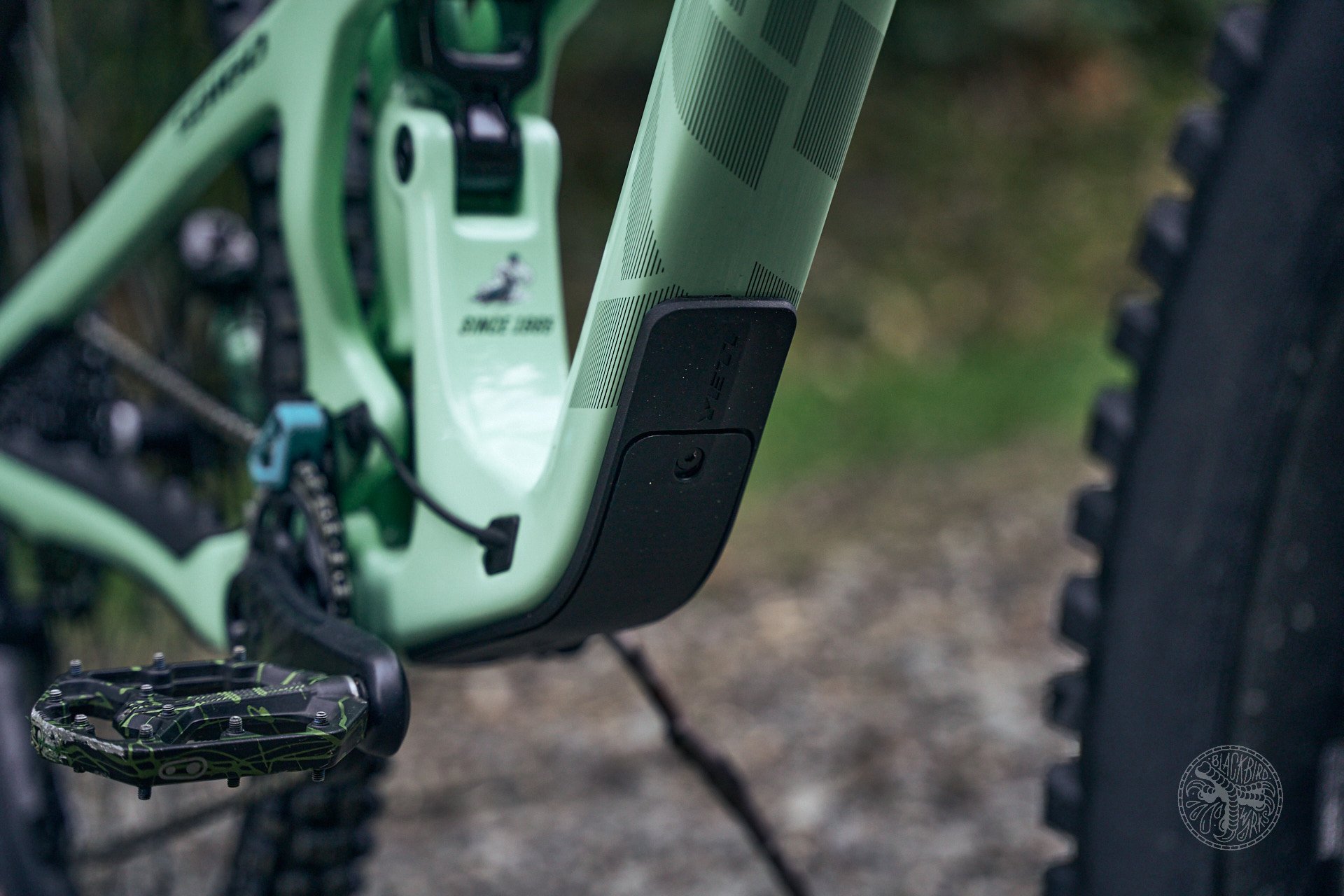
That hatch there is both a replaceable guard and a hatch for... a hole to help you with routing your cables. There is no storage compartment in the SB160.
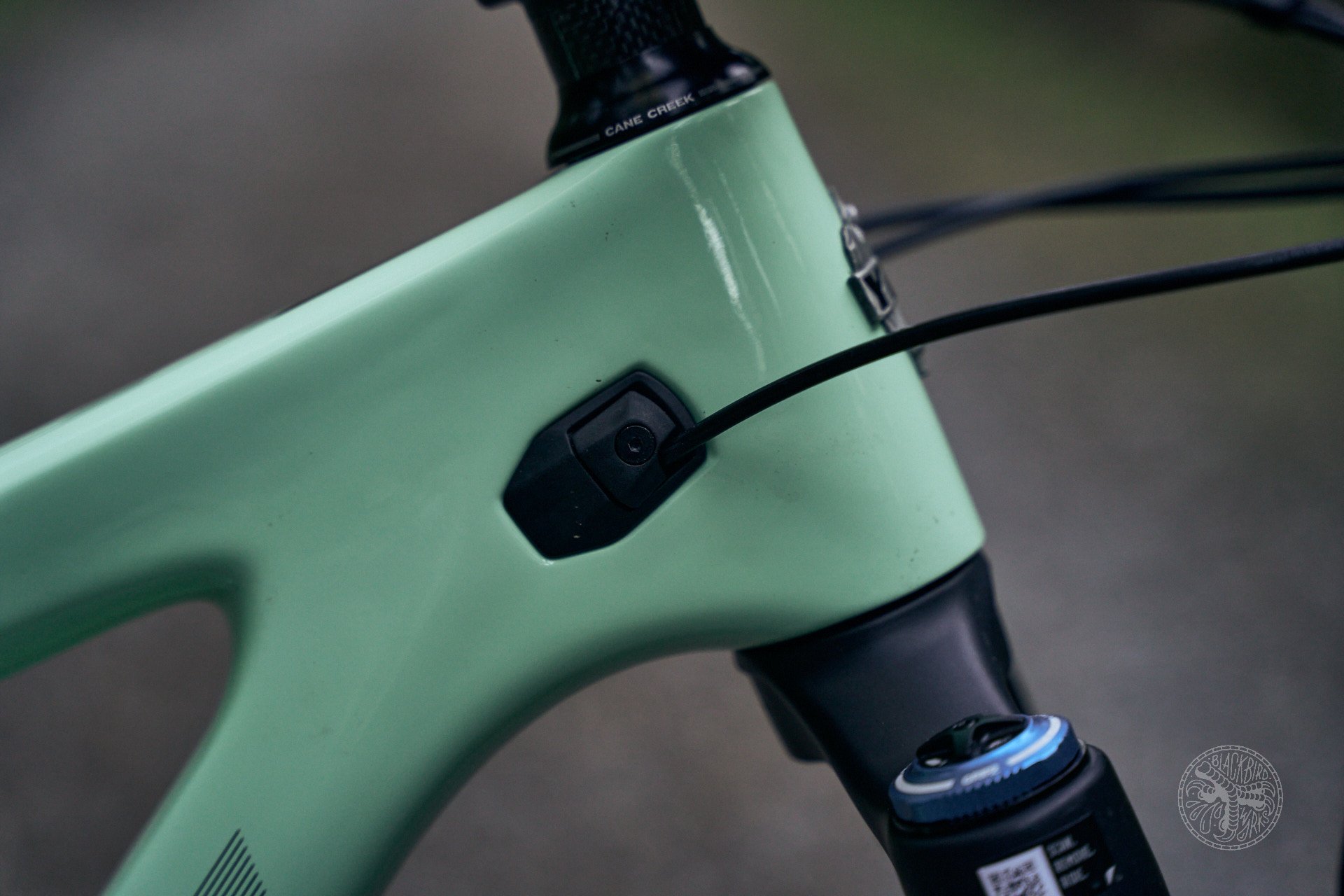
The cable hatches are slick and they lock the cables in place to prevent rattling.

Love this guy!
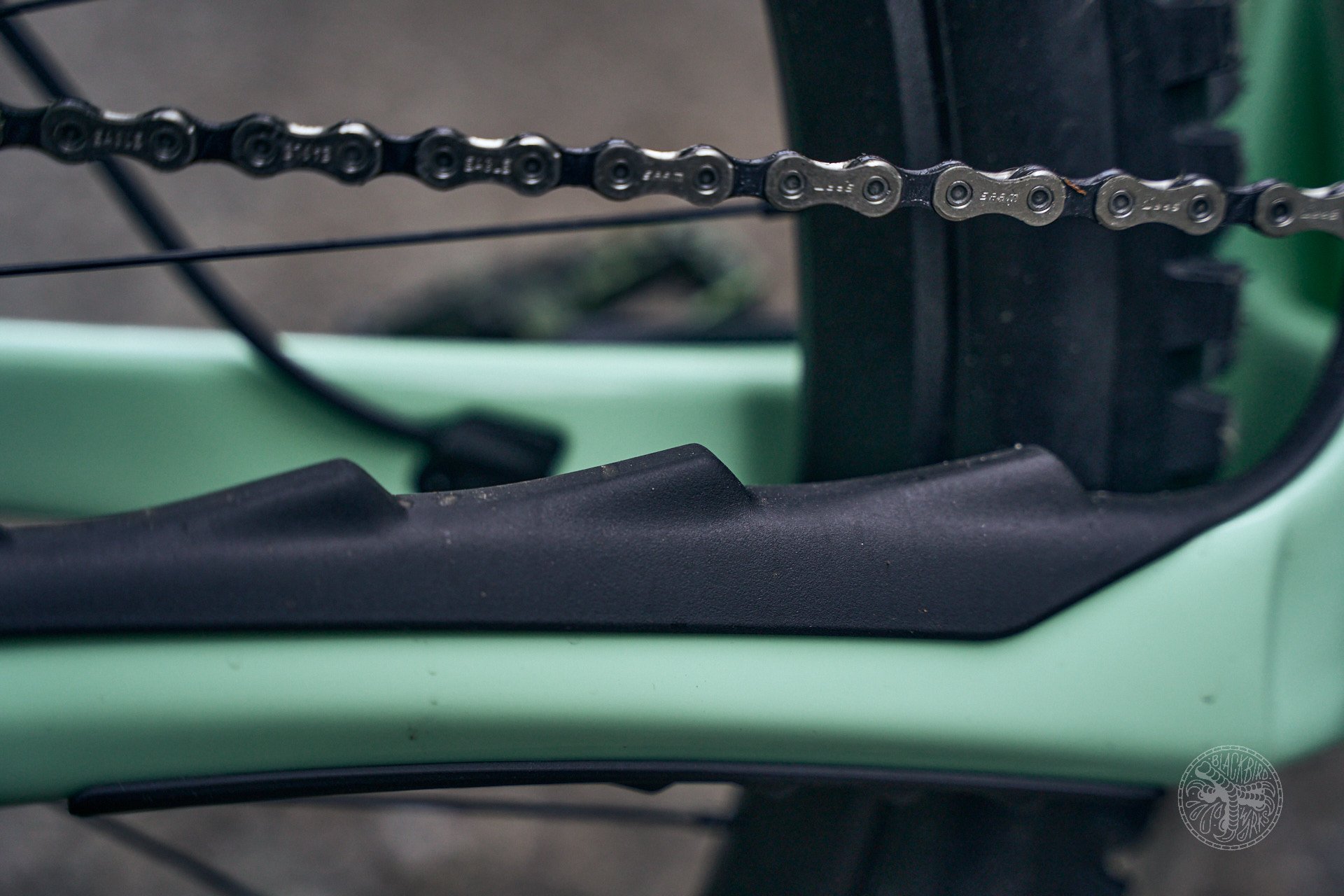
The SB160 runs very quietly, and this chainstay guard likely helps.
Refinements
Unlike the SB150, this bike has a different swingarm for each size. If you ride a medium or large frame this likely won't be a big difference but for riders on either end of the scale, it could be noticeable. The chainstay lengths range from 437mm for size small to 445 for XXL while the SB150 had 433mm stays in all sizes.
A minor complaint I had about the SB150 has been addressed as well; tire clearance. Several tires I installed on the 150 would rub the stays even when the rear wheel was true and properly dished. The clearance now is ample and Yeti says the bike will accept 2.6s easily. The frame also has a more angled initial structure leading away from the bottom bracket and toward the front of the bike, which Yeti says translates into 25% more clearance over obstacles.
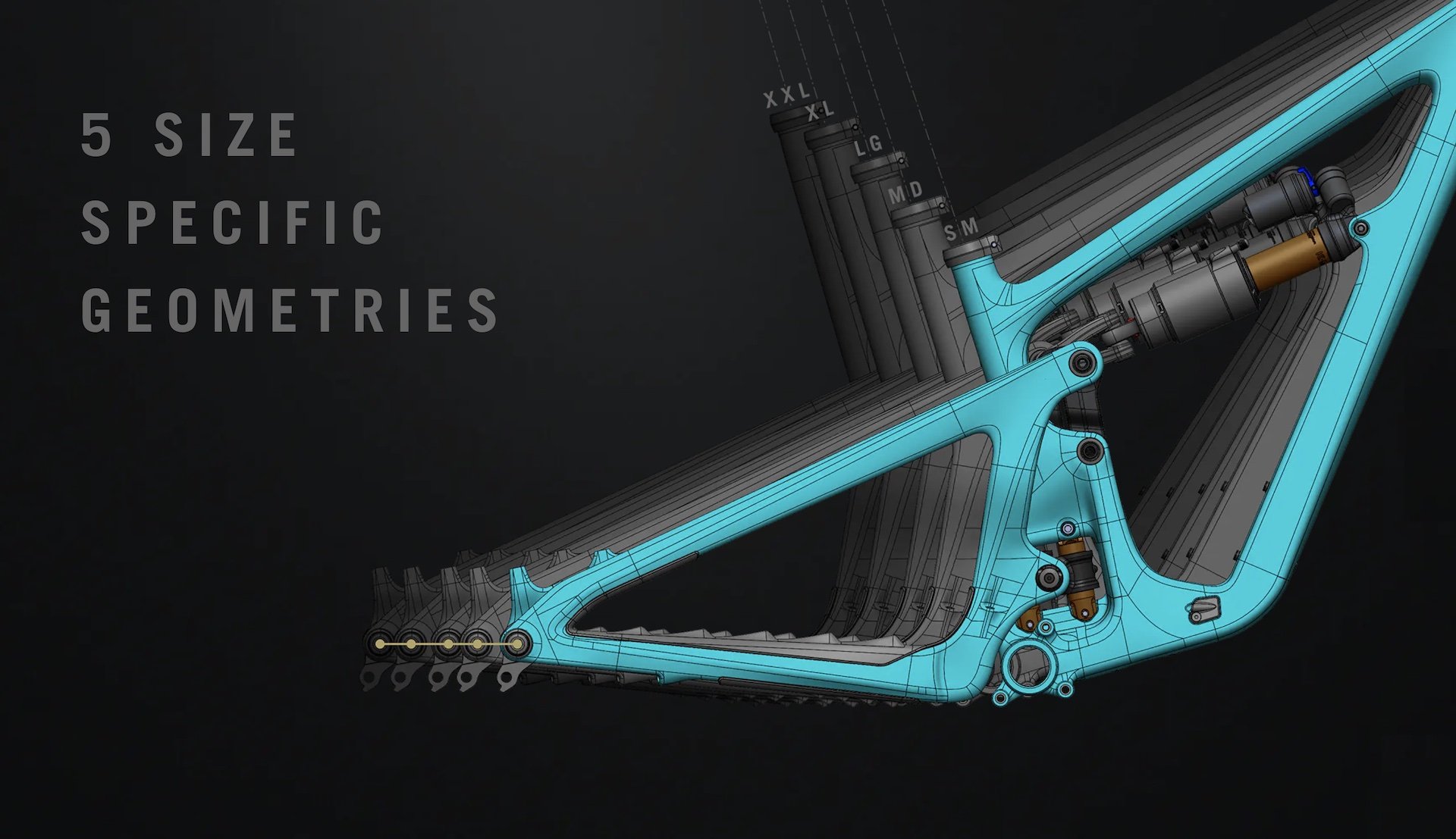
Size specific geometry costs manufacturers more, justifying some of the Yeti premium.
Every cable guide and hatch has been improved over the SB150. A design flaw with that bike was that the suspension's movement would turn the rear brake line, particularly when dirty, into a saw that could gradually wear away the carbon at the entry and exit ports on either side of the bottom bracket. Now there are housing clamps that prevent this from happening as well as cable port covers for the exits (only) in this location that lock the cable or hose in place.
There is a new Switch Infinity mechanism on this bike that has several refinements. I went through a couple of the previous version SI units found on SB150s. The first was on a previously-ridden test bike but the second I had from new. I was quite diligent about maintenance and had installed a makeshift fender but still managed to wear through the Kashima over about 18 months of riding. The new version has an improved bushing for lower friction and longer wear, and bearings that are more resistant to corrosion, which is important considering their location. There are also more effective dust covers over the bearings to keep the muck from getting in.
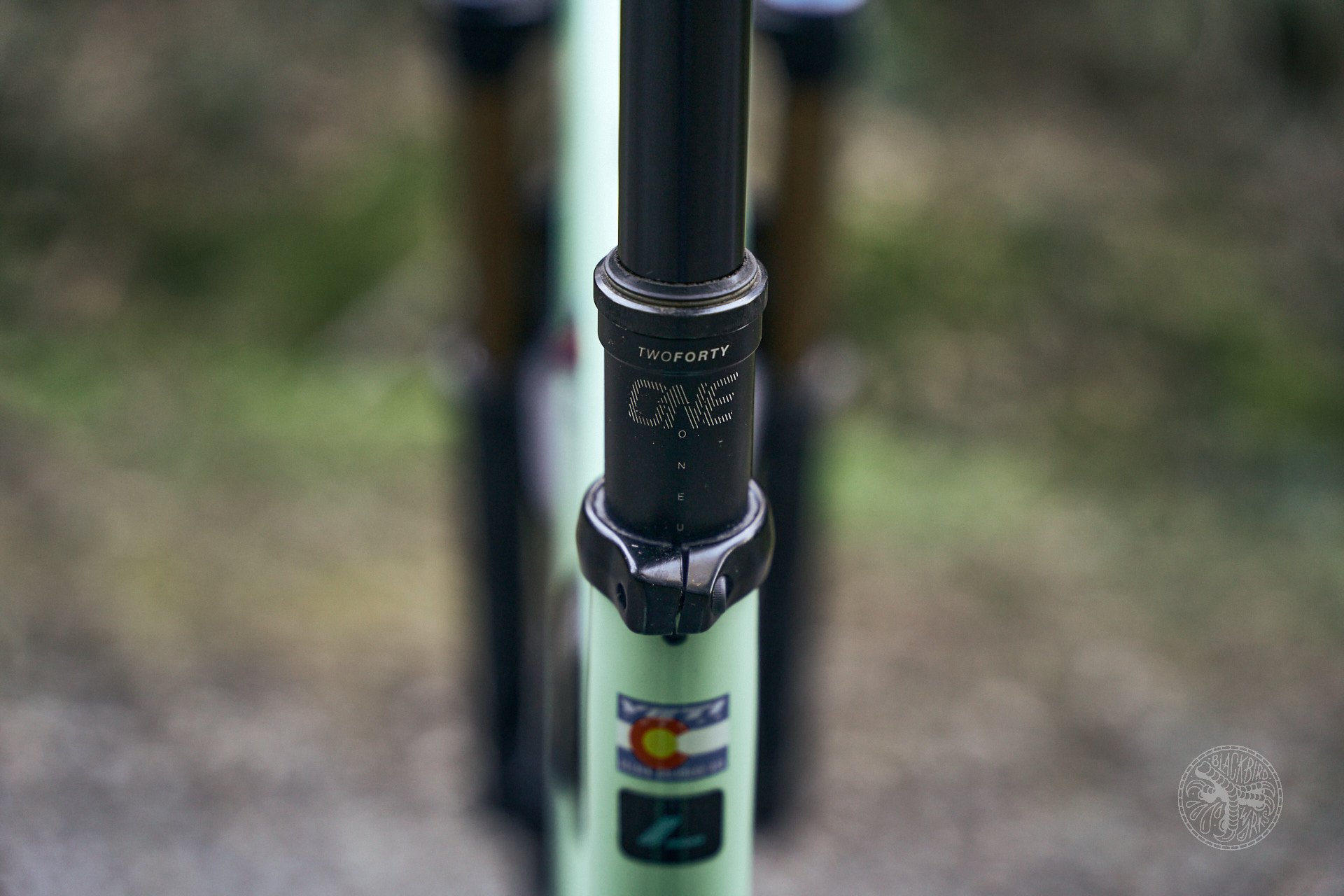
I have become addicted to lots of drop so I swapped in this OneUp 240 (lowered to 220) to replace the stock 200mm Fox Transfer. The lower-end C series frames come with a 210mm OneUp, which I would consider an upgrade in performance and form factor as well as length.
Component Spec.
I was very happy when I opened the bike and started evaluating the build of the T1 model I was sent to test. The T stands for Turq, which is Yeti's high end carbon construction. It's a little lighter than the standard "C" frames and Yeti's copy suggests a little more compliant as well, while both frames are said to be similarly stiff and strong. The T1 is the low end Turq spec. and I was excited by two elements; the absence of batteries and the presence of aluminum wheels. Don't get my wrong, I love carbon wheels, particularly now that they don't rattle your teeth out. I just wanted to see if I could feel any added compliance from aluminum and test a Yeti that was, in theory at least, more reasonably priced.
While the wheels and drivetrain are a step down from full Gucci, the suspension is full Kashima Fox Factory, with a 170mm Fox 38 Grip 2 up front and a Fox Factory Float in the rear. The brakes are SRAM Code RC2s which have been proven to be powerful, sensitive and reliable over many years, and the rotors are 220/200mm. This is as close to an Andrew Major min/max build as you can get from a Turq-framed Yeti, although the SRAM X1 carbon cranks wouldn't pass that test.
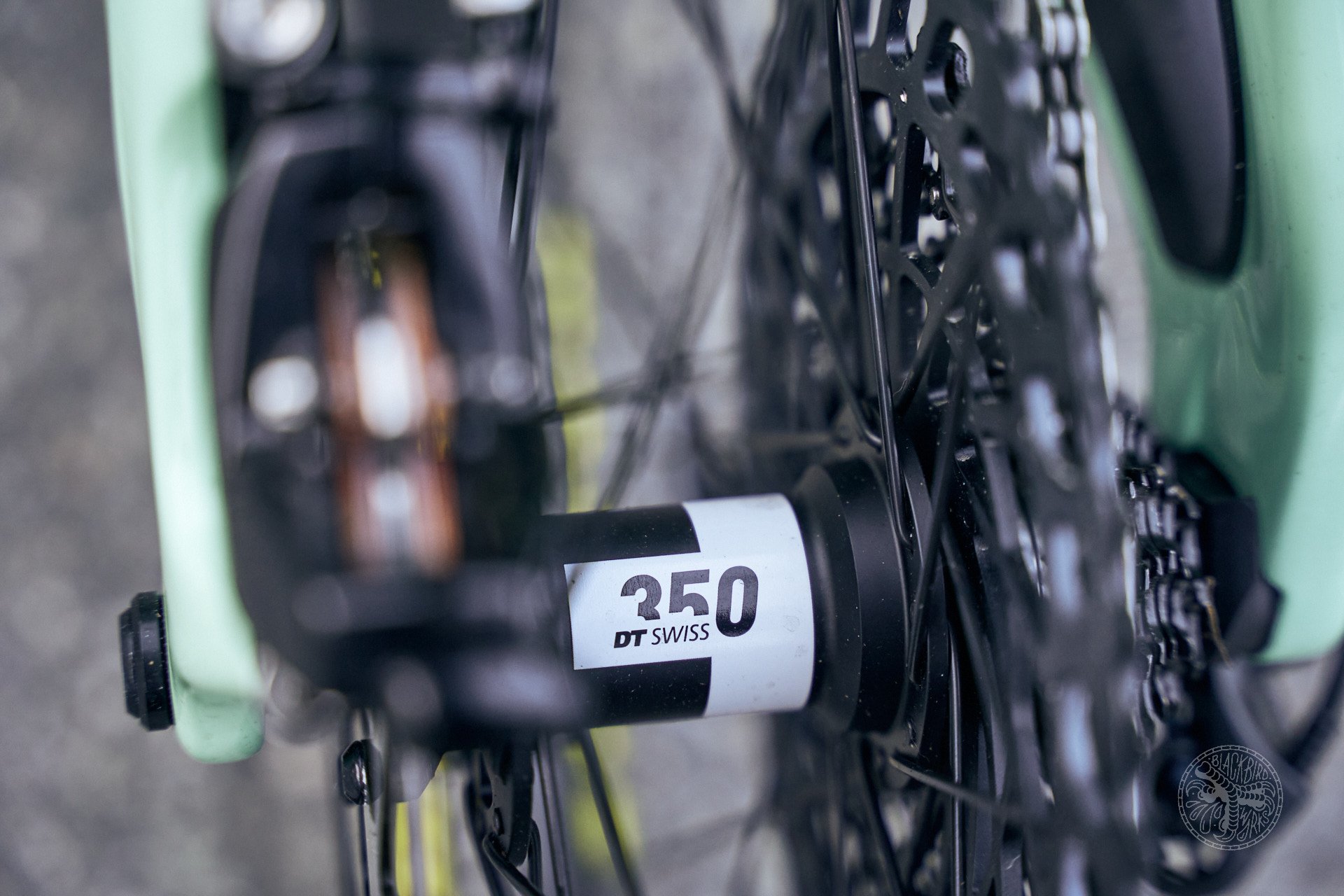
The wheels aren't fancy, but they are excellent. DT Swiss 350 hubs do the job admirably despite being a little heavier than the 240s.
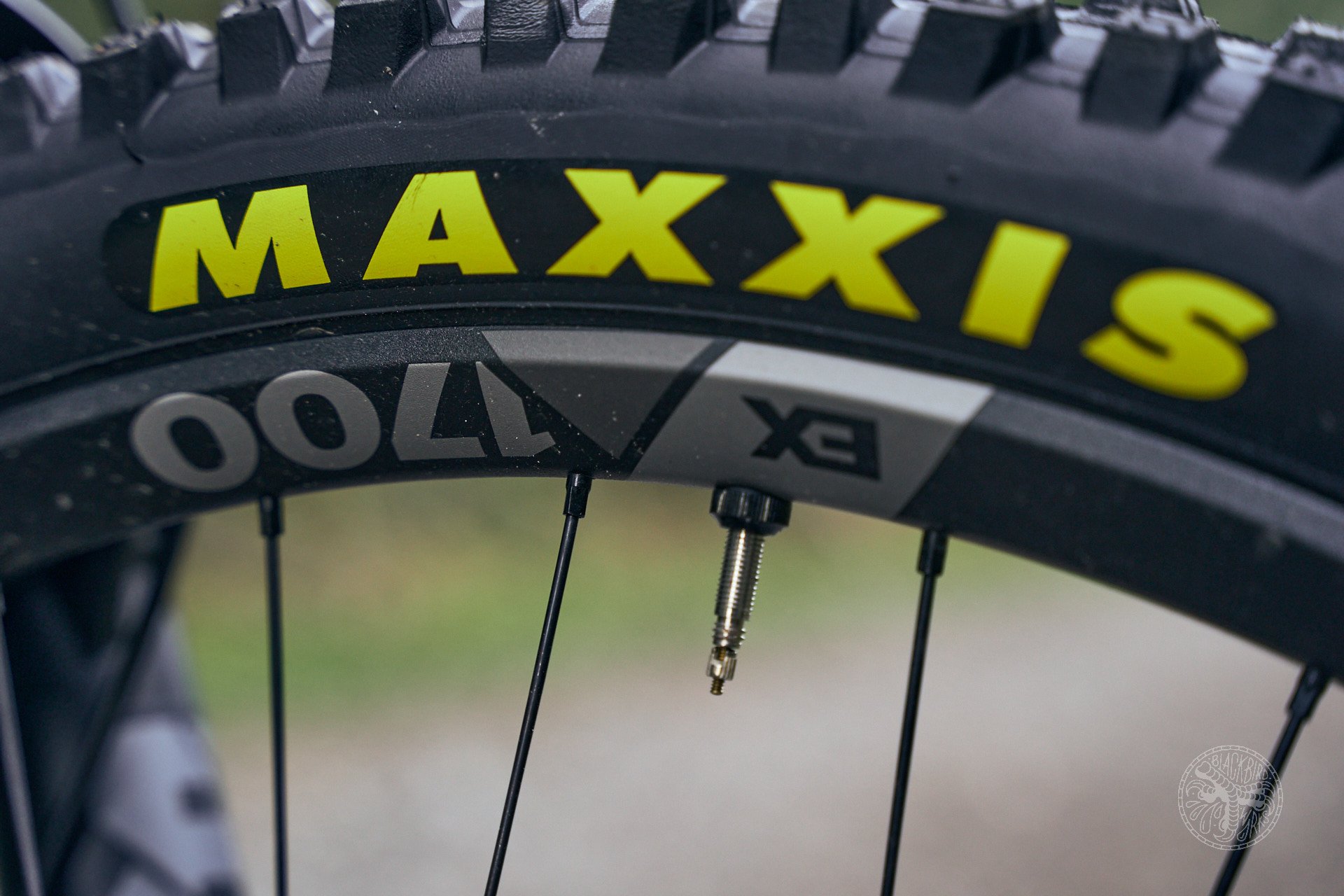
Paired with DT Swiss EX 1700 aluminum rims, they give a comfortable ride and thus far without any dings. MaxxTerra DHRIIs and Assegais provide your grip.
Spec. Gripes
I have a minor gripe about the 200mm seatpost. Despite that being a length I can deal with, I'd prefer something longer. I have a more serious complaint about the XO1 drivetrain with a GX shifter, chain and cassette. While SRAM claims the new GX Transmission chains and cassettes are as durable as the pricier models (we have yet to confirm this) GX Eagle running gear doesn't last nearly as long as XO1 or XX1 in our experience. Obviously Yeti isn't the only bike brand trying to bamboozle us in this way, but I hoped they would do better. In fact, even the T3 model which ships with an XX1 AXS rear derailleur comes with a GX Eagle chain but with an XO1 cassette. Otherwise everything is rosy with (MaxxTerra) Maxxis Minions front (Assegai) and rear (DHRII), a nice WTB Silverado saddle and comfy ODI Elite Pro grips.
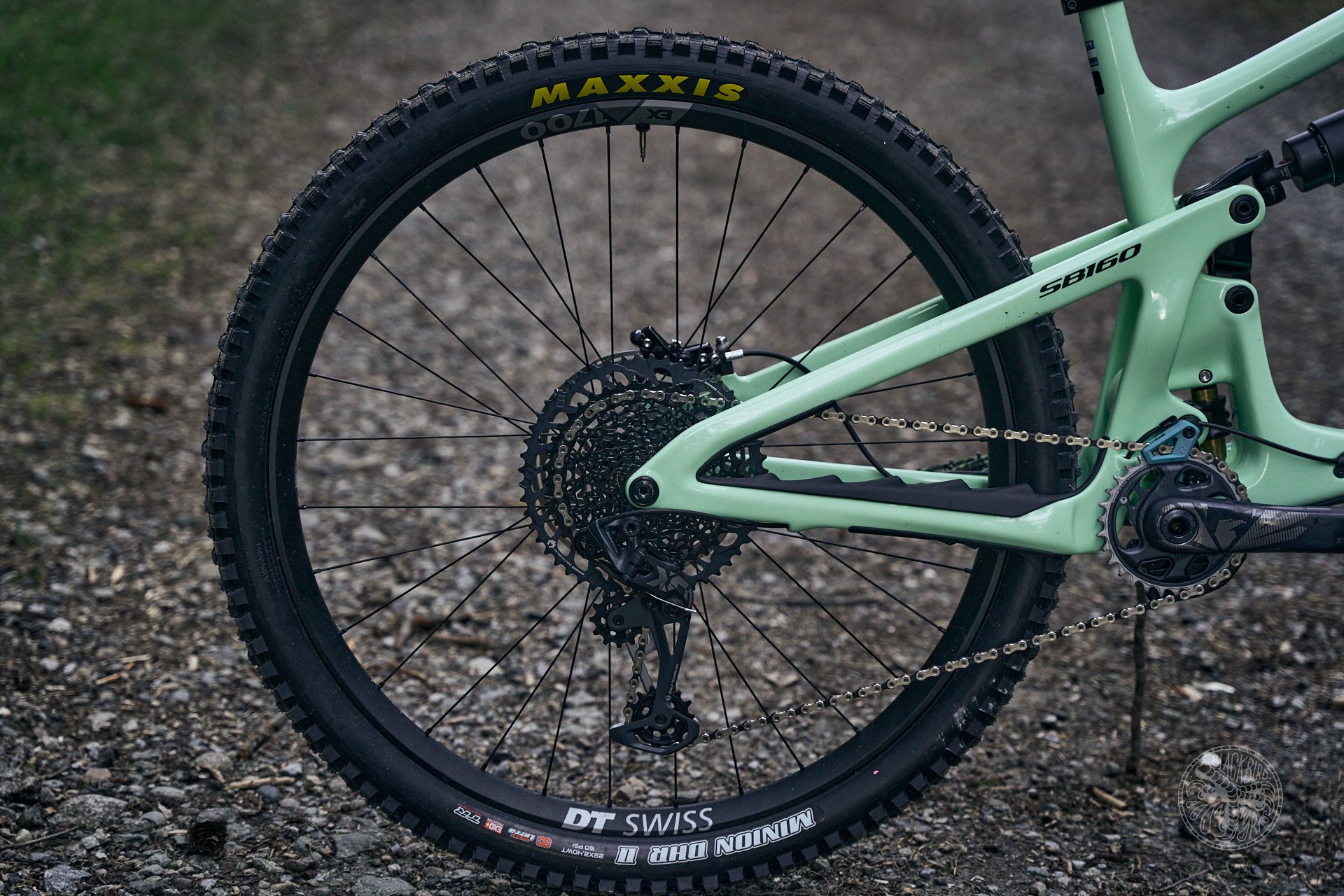
The XO1 cable-actuated drivetrain works great but in a classic bait and switch that the whole industry seems to play, the chain and cassette are GX. They work fine but they don't last as long as XO1 or XX1. The weight difference isn't much but the longer wear of the more expensive parts make them a worthy upgrade when replacement time comes.
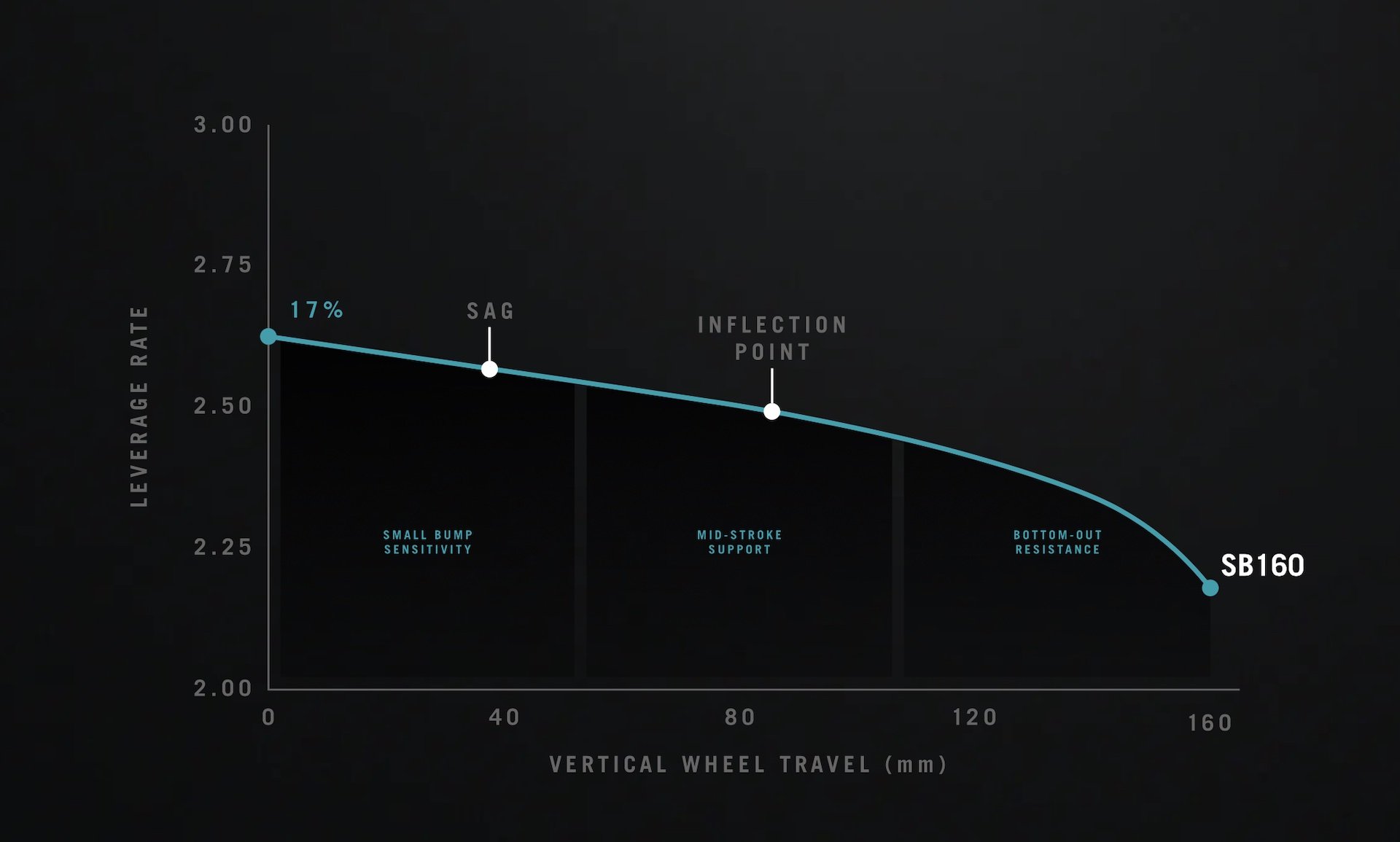
Information provided by Yeti.
Curves
The SB160 is unapologetic about its intentions; this bike is made for racing. The relatively linear leverage curve is evidence of that. The rate starts at around 2.6 according to Yeti, and then increases to around 2.2 for a 17% increase. In contrast the 2023 Megatower starts at 3.1 and moves up to 2.2 for a 29% in the low position. The difference between the two is more than those number would have you believe however because the Mega's curve is quite straight while the SB160 ramps up mostly in the last 20mm of travel. I get along well with linear bikes but heavier riders, coil lovers or those who are looking for a more bottomless feel (although the late ramp helps the SB160 in that regard) may be less keen. If you want to go fast, the way Yeti tells it, linear is the way to the podium.
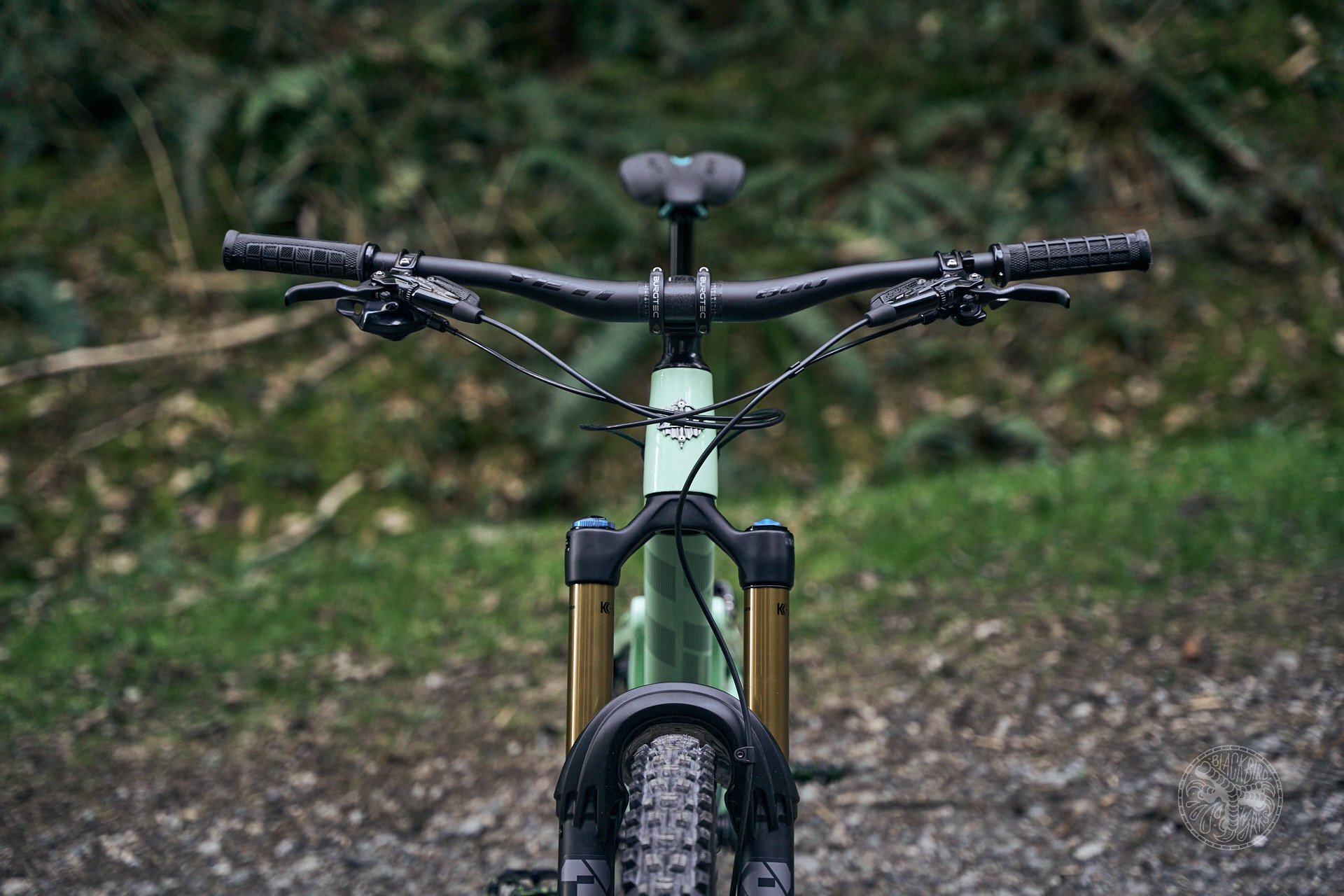
I have no complaints about the Yeti Carbon bar thus far. Even cut down to 760mm it doesn't feel too stiff.
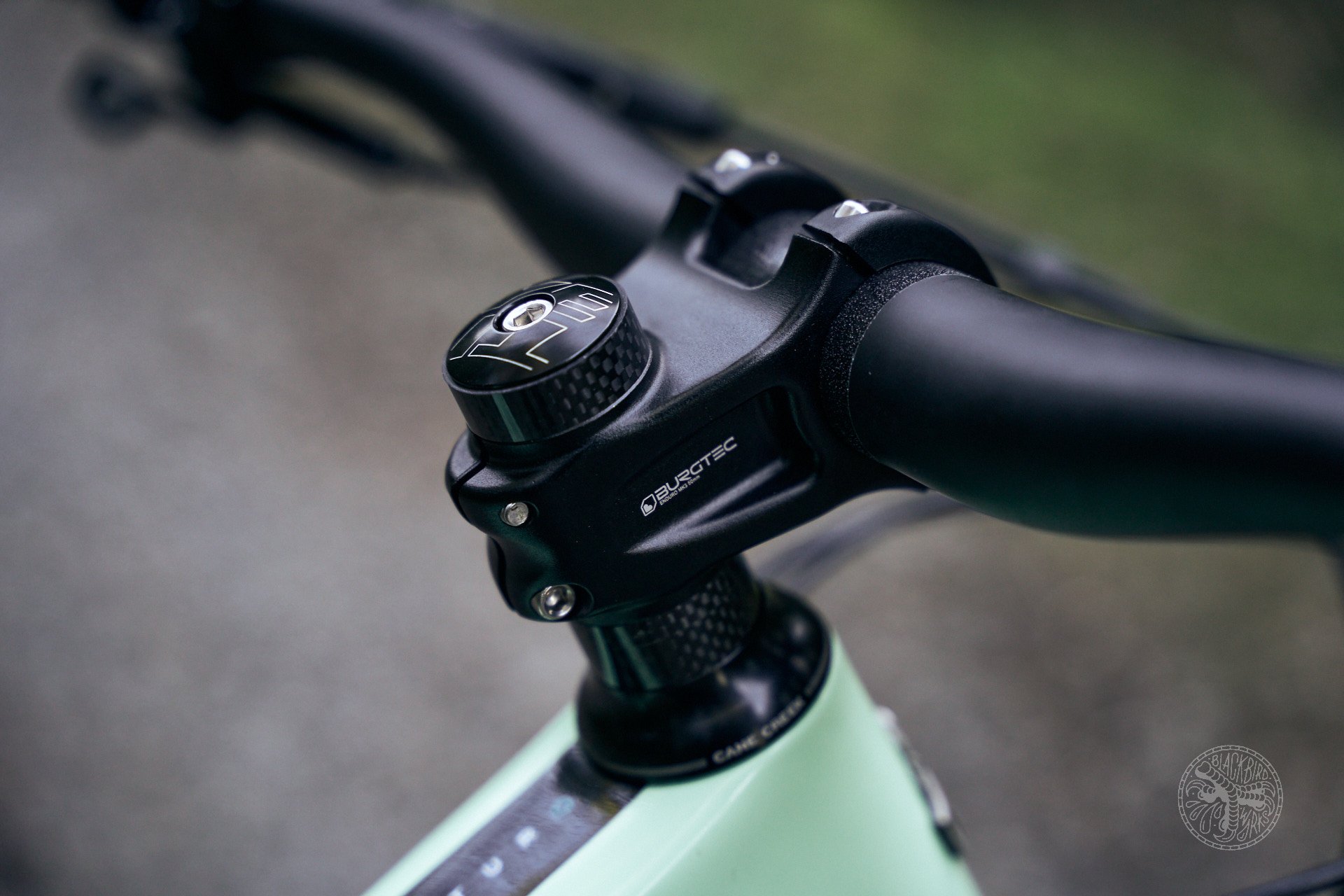
The Burgtec stem is a nice touch in an otherwise relatively vanilla (but French vanilla) build. The Cane Creek 40 integrated headset is a work horse in my experience.
Compared to...
Ideally I'd like to be able to compare the ride of the 150 and 160, which I haven't had a chance to do yet. I have notice that, unsurprisingly, the 160 takes bigger hits with less drama, particularly when there is a hard hit at the bottom of a rock face. I've also noticed an increase in stability. It feels to me like there hasn't been much maneuverability lost, but that may be because the SB160 is a little more agile than my We Are One Arrival 170. Once I have a chance to do back to back laps on an SB150, I'll be able to confirm those hunches.
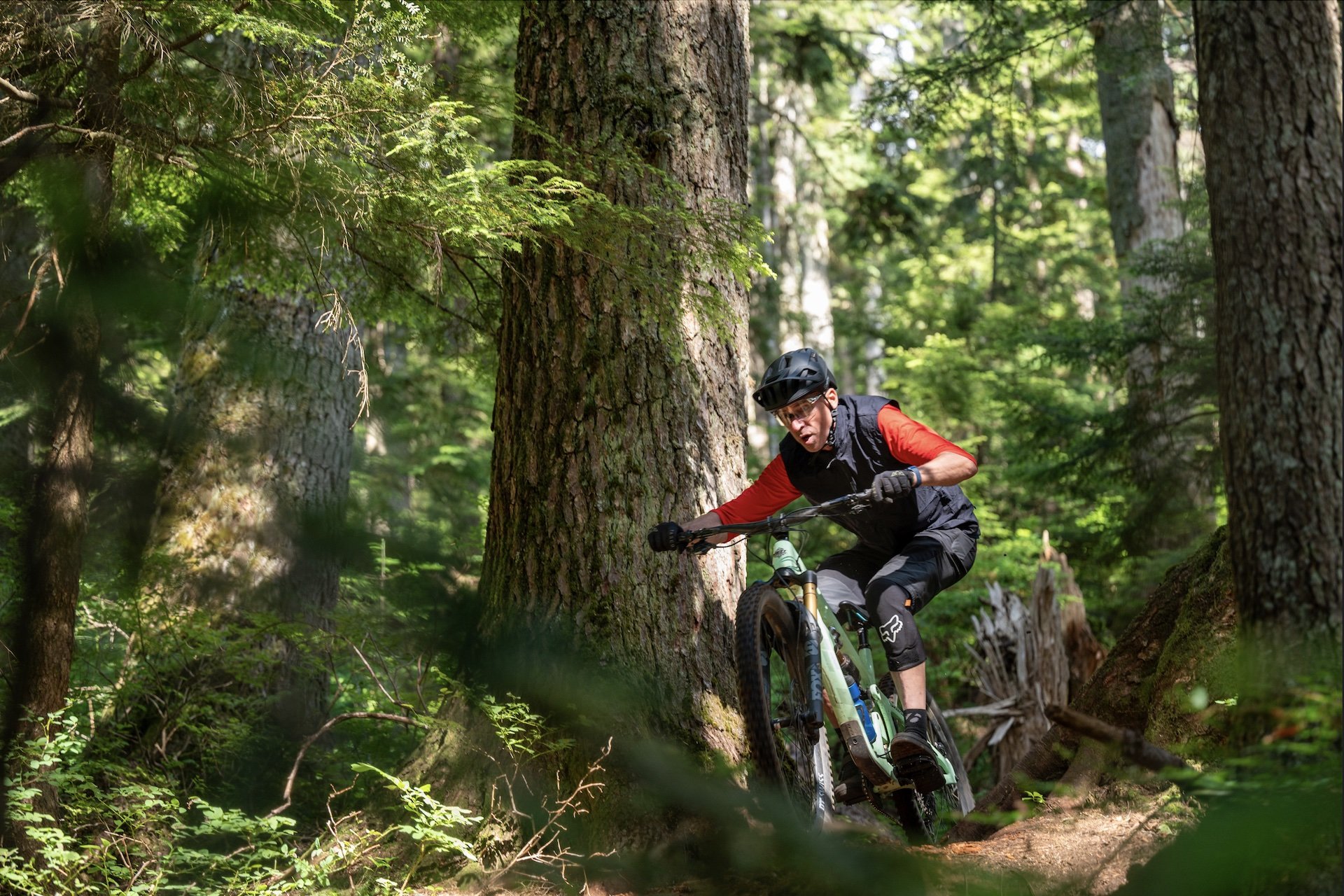
The SB160 responds well to body English. Photo - Zach White
Final Musings
This bike shares a lot with the Yetis I've ridden before. It climbs very well for the amount of travel and control it delivers, it descends with confidence but never feels like a sled, and it's got excellent balance front to rear. I've had some great rides on the SB160 so far but I haven't made it sing yet. I've got the suspension feeling good but I think I can wring some more butter out of it. I'm looking forward to some bike park time, some trips, and lots of descending on this beautiful machine.
I also hope to tear some things apart to see how deep the refinements over the SB150 go, including a bearing swap and servicing the Switch Infinity link.
The MSRP for this bike as you see it is 12,300 CAD or 8,500 USD but there are many fire sales going on right now and I've seen a T3 as low as 9065 CAD and a T1 like this for 5100 USD so at the moment it pays to shop around.
Height - 6'/183cm (mostly legs)
Weight - 170lbs/77kg
Inseam - 33"/84cm
Ape Index - 0.986
Age - 57
Trail I've been stoked on lately - Lower Digger
Bar Width - 760mm
Preferred Reach - 485-500mm (longer with 27.5 wheels than 29)
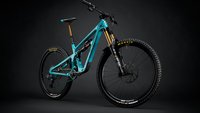


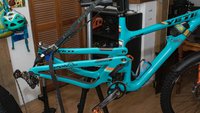
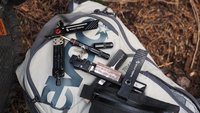

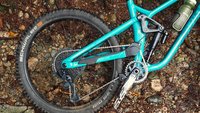

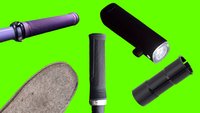


Comments
Ride.DMC
4 months, 2 weeks ago
As Cam alluded to in the article, every bike brand makes some questionable choices when spec'ing their bikes - and more often than not I feel like it's mostly just quibbling on our part as consumers.
But when an extra digit gets added to the left of the decimal on the MSRP I feel like these 'quibbles' become justifiable gripes.
Especially when a company like We Are One can put together a spec that is as good or better for the same amount of money (actually, it may be less) for a comparable bike (travel/category) with a frame, rims, and stem/handle bar that are made locally (seriously how do they do all that for the price they charge???).
Or, on the flip side of the value coin a company like YT can put together the same (or better) spec but for almost half the price.
For that money Yeti should be spec'ing the XO cassette and chain.
They should also be spec'ing a MaxxGrip front tire, and probably a double down rear tire.
They Should probably be giving you your choice of alloy or carbon rims (I think Santa Cruz spec's carbon wheelsets on the Megatower at this price point, but I get that some people prefer alloy).
It is beautiful though - and full credit to Yeti for making size specific geometry.
Reply
Briain
4 months, 2 weeks ago
Yeah, 100% agree. There is nothing about this bike is budget so cost cutting on a non-matching drive train parts. The second point I'd make if you're going to go non-matching I'd spec a higher-end shifter instead of a derailleur
Reply
Morgan Heater
4 months, 2 weeks ago
That Renthal stem really looks like a Burgtec rip-off.
Reply
Cam McRae
4 months, 2 weeks ago
I see what you did there! Good catch. Thanks.
Reply
Erin B
4 months, 2 weeks ago
Very interested to hear your comments on a and b rides against the sb150. I have a 2020 sb150 and love the bike... Long rides/burly rides/jumps, it does everything well, especially at speed. Bike handling is agile and climbs very well for size. When it wears out, I wonder to replace it with SB160, as it seems yeti have improved and refined a lot of things on the frame... Especially the bottom bracket. Though I'm irritated by the lack of x01 full drive train!
Re yeti frame durability/maintenance issues. I've ridden the bike 3 seasons in Alberta, have 2500km on bike and lubed the switch infinity every few months and never had an issue with it. Bottom bracket has however gotten creaky x2... Otherwise I've also had some big falls on the bike (😭) and frame has held up...
Reply
Cam McRae
4 months, 2 weeks ago
I've heard some good things about the spec of soon-to-be-released models so that may be less of an issue.
Reply
hotlapz
4 months, 2 weeks ago
how does a bike with so many design flaws get priced this high
Reply
Cr4w
4 months, 2 weeks ago
What flaws other than price or lack of in-frame storage (is that even really a flaw?)? It sounds like they addressed most of the issues from the previous model.
Reply
Hugo Williamson
4 months, 2 weeks ago
A well designed 4 bar can achieve the same kinematics without the BS of the Yeti Switch links. So yeah,overpriced,over engineered for the sake of it. IMHO of cour
Reply
Briain
4 months, 2 weeks ago
Until you put real miles and a winter or 2 on this thing it would be hard to say it's really been addressed hard to do in an initial review but still
Reply
Cam McRae
4 months, 2 weeks ago
I believe all of the flaws I mentioned were related to the SB150. The seatpost length is a personal preference that is probably a little ridiculous and while the absence of in-frame storage is a negative for me, I’d hardly call it a flaw. It certainly wouldn’t steer me away from riding a Yeti.
As for the GX running gear and shifter, that’s an industry-wide flaw. I normally have many more gripes about a brand new platform.
This is a very well sorted bike that rides very well indeed and the size-specific swing arm raises it to another level.
Reply
Justin White
4 months, 2 weeks ago
I'd rather have them try to hit margins on the chain and cassette rather than the mech.
Maybe it's better lately, but GX mechs used to have simply terrible B-pivot hardware (I think GX AXS gets the same pivot hardware as XO, but not sure about the latest mechanical). It would wear and get sloppy so fast, you'd think the hanger was bent but you could never get it straight enough. Sure, the GX chain is basically butter with almost nothing hardened, but you expect a chain to wear, and it's only like $60 to replace with XO, vs like $250 retail for the better mech.
And GX cassettes seem to last a pretty long while, especially if you right quick ditch that soft GX chain for XO or better, so the weight penalty is the real issue there, IMO.
That T3 model with GX chain and everything else higher is a real travesty, too.
Reply
LWK
4 months, 2 weeks ago
I clicked on the MTB engineer link... just wow. If what he said is correct, there were tolerances up to 6x what should have been. That is an impressively bad level of design/engineering and/or manufacturing QC.
Reply
Ceecee
4 months, 2 weeks ago
Because there's no way the fork could have been fixed locally. Spanish Underpants fire sale
Reply
Glenn Bergevin
4 months, 2 weeks ago
I know they're nice bikes, but the whole dentist/boomer image I associate with them is hard to get over. Then I see one looking good on the trail, read a favorable review...
Then I see 'vertical fork travel' on a geo chart and nope right back out...
Reply
Cam McRae
4 months, 2 weeks ago
Interesting. What is your issue with that geo measurement?
Reply
Glenn Bergevin
4 months, 2 weeks ago
It's just nonsense boomer marketing math. It has no functional relationship to the bikes performance. Head angles are dynamic. There is no corresponding rear travel measurement. I could go on, but it's just... Dumb.
Reply
Perry Schebel
4 months, 2 weeks ago
it's a dynamic & somewhat arbitrary metric, but i do understand where they're coming from - ie, measuring fr & rr travel similarly, indicating "balanced" suspension (which, measured conventionally, might be considered "over-forked").
Reply
Cam McRae
4 months, 2 weeks ago
I wondered why they included it actually and that makes some sense. Whether it has much value for consumers is another question because unless others adopt it as well you are comparing apples to nothing - although along with static head angle it wouldn't be a tricky calculation.
Reply
Justin White
4 months, 2 weeks ago
It's actually quite easy to estimate: about 10-20 mm on a recent trail bike depending on head tube: slacker, and longer in-line travel, means more reduction.
66 degress turns 170 into 155.3, 150 into 137.0. 63 degrees turns 170 into 151.4, 150 into 133.6:
14.7, 13.0, 18.6, 16.4 (I was pretty close with 10-20!)
Call it a 15mm, more-or-less, reduction from in-line travel to derive vertical fork travel , and you'll be pretty close for most bikes.
Justin White
4 months, 2 weeks ago
Actually there is a corresponding rear travel measurement, because no bike on the market right now has a perfectly vertical axle path. One thing to look at first is that we really don't know what rear travel numbers are measuring. The arc of a single pivot? Best-fit arc for a multi-link with a non-uniform path? The actual distance along that multi-link path? Straight-line vertical travel?
You're correct that it's a dynamic number because head angle changes and such, but that goes for almost everything on a bike, and it's just another reference point. I know lots of people who say they like the balance when the front has 10-20mm more travel, thus putting vertical travel within a few mm of the (often assumed vertical) rear travel; so knowing this number would be quite useful. I also know lots others that like the stated travel numbers to match, it's just a preference and a ride style
Reply
BadNudes
4 months, 1 week ago
They added it because they were tired of responding to set-in-their-ways boomers' emails outlining their concerns and confusion over the "new trend" of the stock fork having more travel than the frame.
Reply
Justin White
4 months, 1 week ago
I actually think the new trend is matching numbers. Pivot has done "reverse mullet" longer-in-front for a while, some dealers even made a point of pointing it out. The 140-150F/125-130R bike was pretty much the norm for "trail bike" about a decade or more ago, and that was when head tube angles were steeper and the difference between in-line and vertical fork travel was even smaller!
Reply
Dave Smith
4 months, 2 weeks ago
How did it size up size wise? I've heard a few ~6'-ish folks say that they wish that they had opted for the xxl instead of an XL
Reply
Cam McRae
4 months, 2 weeks ago
Do you mean L and XL? The L is 485 reach and the XL is 510 - which is too long for me. The XXL is 525.
I'm on the large and it's great. My sweet spot is probably closer to 495 these days but 485 on this bike feels just fine.
Reply
Dave Smith
4 months, 2 weeks ago
A few local folks on the 160 who are prone to mega-stack height opted for XL over the recco'd Large and then after a few rides found themselves wishing for XXL.
I know you like a few spacers under your stem so I wondered if you found your reach affected.
Reply
Chad K
4 months, 2 weeks ago
I'm 6ft exactly and have been very happy on a size L. That said, I don't run a ton of stack on any of my bikes. From a standard short Canecreek topcap, I have 15mm spacer, a 50mm 0* stem, and 35mm rise bars, just as a frong end height reference.
480-485 is my personal reach sweetspot (Not far off Cam's), so I can't imagine even considering ans XXL
Reply
Dave Smith
4 months, 2 weeks ago
I suspect fit and feel in this longer reach era is a bit of a subjective game. For me, I felt like the fit was spot on with the XL 150 and 5.5's I've been lent for different spells over the years. Recently, the 2 folks I am thinking of were the same way and have been serial yeti customers for years but we were all a bit surprised how small the XL suddenly felt but that might have something to do with the stack of spacers cramping their feel.
Reply
Chad K
4 months, 2 weeks ago
Oh, that's a great point, Dave! I'm very particular about not having a bunch of spacers (most other bikes I have it's only 5-10mm), in order to not artificially decrease the reach.
Admittedly, I may also like a slightly lower front end than most, as well.
Cam McRae
4 months, 2 weeks ago
I had quite a few spacers on the Arrival but it has a very short head tube. Not much stack on this one and it feels great.
Reply
XXX_er
4 months, 2 weeks ago
Duno if its the mullet but compared to the 5.5 I found the longer slacker Bullit goes around corners easier
Reply
Dave Smith
4 months, 2 weeks ago
This comment has been removed.
Cam McRae
4 months, 2 weeks ago
Luckily it was easily fixed. I ordered the appropriate shims from Ali Express for a couple of bucks and after that it worked perfectly.
Reply
Timer
4 months, 2 weeks ago
That sounds like the kind of solution that would be acceptable for a budget bike or some killer deal from the early days of YT.
But a complete and utter failure on a Yeti with a five-digit price tag.
Reply
BarryW
4 months, 2 weeks ago
@Timer That sounds like the kind of solution that is simply unacceptable on anything but a Walmart bike.
And this is the highest of dollars bike.
Reply
Speeder1
4 months, 2 weeks ago
Please do a long term follow up review on this bike when approriate. I love my 150 and just got a new '22 frame last year after a big rock strike busted my '19 frame. I've had no issues with premature wear on pivots or SI, the bike has been excellent. Don't feel compelled to change up at this point...
How about that long term review on the 140 and the 120 Mr. Ferrentino?
Reply
Cam McRae
4 months, 2 weeks ago
I will certainly be following up with a full review Speeder!
The rationale with our two review format is to get most of the spec discussion out of the way so we can focus on how the bike rides, maintenance, suspension settings and other important matters that tend to be muddied by component talk.
Reply
Velocipedestrian
4 months, 1 week ago
When I first read this piece, something about Newport Covers tickled the messy pile of music references in my head...
At first I thought it was related to the Newport Jazz Festival, but no, eventually This bubbled up, like a chunk of soap bar through dirty water. If Flight of the Conchords Robots, but less 'nice boys from Wellington' and more 'ratboy', I leave you with Half Man Half Machine.
Reply
Please log in to leave a comment.